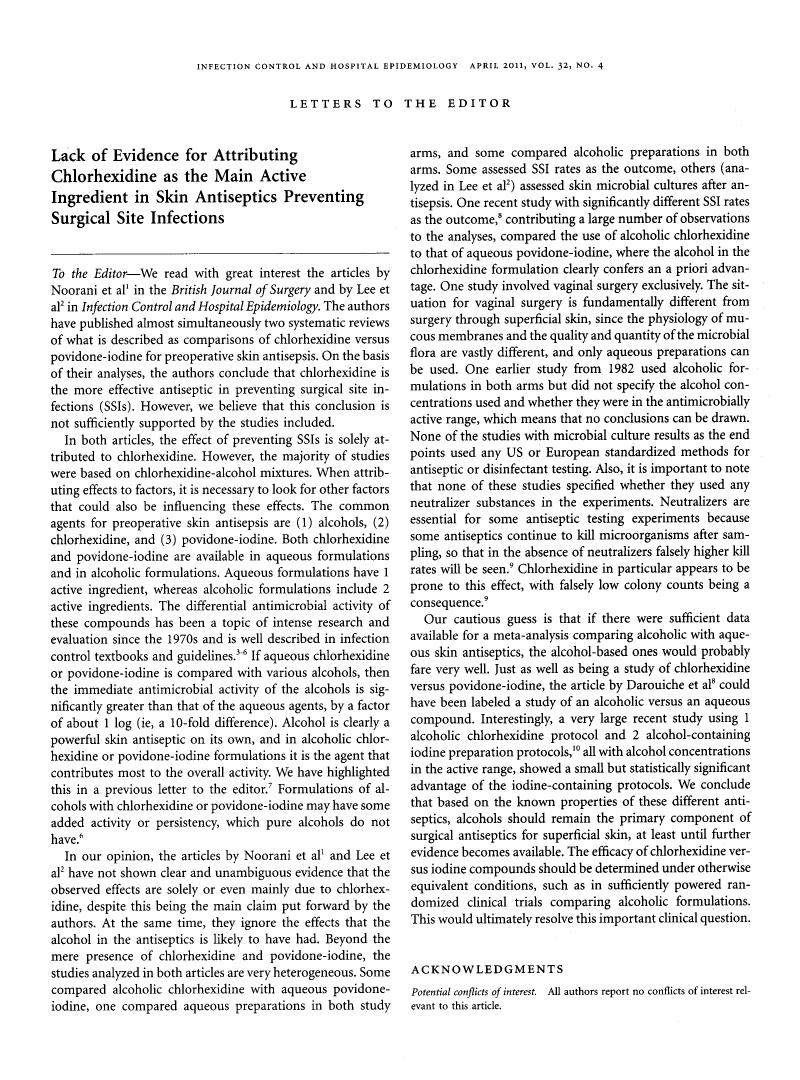Crossref Citations
This article has been cited by the following publications. This list is generated based on data provided by Crossref.
Lee, Ingi
Fishman, Neil O.
Agarwal, Rajender K.
Lee, Bruce Y.
and
Umscheid, Craig A.
2011.
Reply to Maiwald et al and Riccio et al.
Infection Control & Hospital Epidemiology,
Vol. 32,
Issue. 4,
p.
406.
Maiwald, M
Widmer, A F
and
Rotter, M L
2011.
Letter 2: Systematic review and meta-analysis of preoperative anti- sepsis with chlorhexidine versus povidone–iodine in clean-contaminated surgery (Br J Surg 2010; 97: 1614–1620).
British Journal of Surgery,
Vol. 98,
Issue. 3,
p.
461.
Schweizer, Marin L.
and
Herwaldt, Loreen A.
2012.
Surgical site infections and their prevention.
Current Opinion in Infectious Diseases,
Vol. 25,
Issue. 4,
p.
378.
Charehbili, Ayoub
Swijnenburg, Rutger-Jan
van de Velde, Cornelis
van den Bremer, Jephta
and
van Gijn, Willem
2014.
A Retrospective Analysis of Surgical Site Infections after Chlorhexidine–Alcohol versus Iodine–Alcohol for Pre-Operative Antisepsis.
Surgical Infections,
Vol. 15,
Issue. 3,
p.
310.
Maki, Dennis G
2014.
Chlorhexidine's role in skin antisepsis: questioning the evidence–Author's reply.
The Lancet,
Vol. 384,
Issue. 9951,
p.
1345.
Throckmorton, Alyssa D
and
Degnim, Amy C
2015.
Infections After Breast Surgery: Potential Ways to Reduce Infection Rates.
Breast Cancer Management,
Vol. 4,
Issue. 1,
p.
17.
Salama, Fekria A.
Yehia, Amr H.
Wahba, Karim A.
and
Abdelmoniem, Rasha M.
2016.
Efficacy and safety of chlorhexidine versus povidone-iodine skin antisepsis in reducing surgical site infection in cesarean sections.
Evidence Based Womenʼs Health Journal,
Vol. 6,
Issue. 1,
p.
32.
Privitera, Gaetano Pierpaolo
Costa, Anna Laura
Brusaferro, Silvio
Chirletti, Piero
Crosasso, Paola
Massimetti, Gabriele
Nespoli, Angelo
Petrosillo, Nicola
Pittiruti, Mauro
Scoppettuolo, Giancarlo
Tumietto, Fabio
and
Viale, Pierluigi
2017.
Skin antisepsis with chlorhexidine versus iodine for the prevention of surgical site infection: A systematic review and meta-analysis.
American Journal of Infection Control,
Vol. 45,
Issue. 2,
p.
180.
Sun , Ning
Li , Dongli
Chen, Xiaoqing
Wu , Panpan
Lu , Yu-Jing
Hou, Ning
Chen, Wen-Hua
and
Wong, Wing-Leung
2019.
New Applications of Oleanolic Acid and its Derivatives as Cardioprotective Agents: A Review of their Therapeutic Perspectives.
Current Pharmaceutical Design,
Vol. 25,
Issue. 35,
p.
3740.



